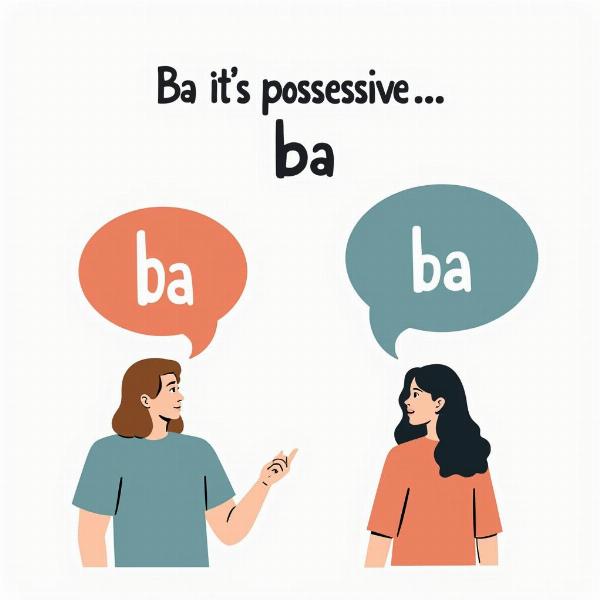Understanding the meaning of “ba” (बा) in Hindi is crucial for anyone learning the language. While seemingly simple, this word carries multiple meanings and functions depending on context. This article will explore the various interpretations of “ba” in Hindi, providing examples and clarifying its usage in different grammatical situations.
Decoding the Multifaceted “Ba” (बा)
“Ba” (बा) can act as a suffix, a postposition, or even a standalone word. Its most common function is as a suffix indicating possession, similar to the English “‘s”. Let’s delve into the different ways “ba” (बा) is used:
“Ba” (बा) as a Possessive Marker
When attached to a noun or pronoun, “ba” (बा) denotes possession or belonging. For instance, “Ram ka kitaab” (राम का किताब) means “Ram’s book.” Here, “ka” (का) is the masculine possessive marker. However, when the noun is feminine, “ka” changes to “ki” (की). Now, if we’re talking about a respected male figure, “ka” transforms into “ke” (के). This is where “ba” (बा) comes in. When speaking informally, “ke” (के) can be shortened to “ba” (बा). So, “Ram ke pita” (राम के पिता) – Ram’s father – can become “Ram ba pita” (राम बा पिता) in colloquial Hindi, specifically in certain dialects like Bhojpuri and Magahi.
 Ba as Possessive Marker
Ba as Possessive Marker
“Ba” (बा) as a Postposition
“Ba” (बा) can also function as a postposition, particularly in certain dialects, indicating direction or location. It often combines with other words to create specific meanings. For example, “ghar ba” (घर बा) translates to “at home” or “to the house.”
“Ba” (बा) as an Independent Word
In some contexts, “ba” (बा) can stand alone as an informal term for “father” (पिता – pita). This usage is predominantly found in specific regional dialects.
Understanding the Nuances of “Ba” (बा)
While the possessive use of “ba” (बा) is relatively straightforward, it’s important to note its regional and informal nature. Using it in formal writing or with individuals from regions where it’s not common can lead to misunderstanding.
Regional Variations in Usage
The prevalence and acceptance of “ba” (बा) vary across Hindi-speaking regions. While widely understood in some areas, it might be unfamiliar or even considered incorrect in others. Therefore, it’s essential to be mindful of the context and audience.
Formal vs. Informal Contexts
Using “ba” (बा) is generally inappropriate in formal settings like business meetings, academic writing, or official correspondence. Sticking to the standard “ka” (का), “ki” (की), and “ke” (के) is recommended for clear and respectful communication.
Mastering “Ba” (बा) in Everyday Conversations
For learners aiming for fluency in conversational Hindi, understanding “ba” (बा) can be valuable, particularly when interacting with native speakers from regions where it’s prevalent. However, remembering its informal nature and using it judiciously is crucial.
Conclusion: “Ba” (बा) – A Small Word with Big Implications
Though seemingly a small word, “ba” (बा) plays a significant role in Hindi grammar and reflects the language’s rich regional diversity. Understanding its various meanings and usage can enhance your comprehension and communication skills, especially in informal settings. Remember to use “ba” (बा) appropriately, considering the context and your audience, to ensure effective and respectful communication.
FAQ:
- Is “ba” (बा) grammatically correct? Yes, in informal contexts and specific dialects, “ba” (बा) is grammatically correct.
- Can I use “ba” (बा) in formal writing? It’s best to avoid using “ba” (बा) in formal writing.
- What is the difference between “ka” (का) and “ba” (बा)? “Ka” (का) is the standard possessive marker, while “ba” (बा) is an informal and dialectal variation, often used for respected males.
- Where is “ba” (बा) most commonly used? “Ba” (बा) is prevalent in certain dialects of Hindi, particularly in regions like Bihar and eastern Uttar Pradesh.
- How can I learn more about regional variations in Hindi? Exploring resources on Hindi dialects and interacting with native speakers from different regions can provide valuable insights.
Meaning-Hindi.in is your one-stop solution for all your Hindi translation needs. We offer a wide range of services, from business and legal document translation to website localization and specialized technical translation. Our team of expert linguists ensures accurate and culturally sensitive translations, catering to diverse industries and academic fields. Contact us today for high-quality, fast, and reliable Hindi translation services. Email: [email protected], Phone: +91 11-4502-7584. For all your translation requirements, trust Meaning-Hindi.in.